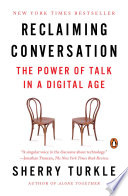

Sherry Turkle examines how the rise of digital technology has led to a significant decline in face-to-face conversations. She argues that while technology connects us in many ways, it simultaneously distances us from genuine human interaction. This decline has profound effects on our relationships, empathy, and understanding of one another. Turkle emphasizes that conversations are essential for developing the ability to listen, reflect, and engage with others meaningfully. The book discusses various studies and personal anecdotes to illustrate how individuals, especially younger generations, are increasingly opting for text messages and social media interactions over direct conversations. This shift not only affects personal relationships but also impacts professional environments, where collaboration and communication are vital. The author calls for a conscious effort to reclaim the art of conversation, suggesting that we need to create spaces and opportunities for face-to-face dialogue, both in personal and professional contexts.
Continue readingTurkle highlights the crucial role of empathy in conversations and how technology can diminish our capacity for empathetic engagement. Empathy requires an understanding of others' feelings and perspectives, which is often best achieved through direct, in-person communication. The book discusses how digital communication can lead to misunderstandings and a lack of emotional connection. Turkle argues that without empathy, our relationships can become superficial and transactional. She provides examples of how empathy can be fostered through conversation, encouraging readers to prioritize empathetic listening and to be present with others. The author also explores the implications of a lack of empathy in various contexts, including education, parenting, and the workplace, emphasizing that cultivating empathy is essential for building stronger communities and healthier relationships.
Continue readingOne of the central themes of 'Reclaiming Conversation' is the idea that technology should serve as a tool to enhance, rather than replace, human interaction. Turkle argues that while technology offers convenience and speed, it cannot replicate the depth and richness of face-to-face conversations. She encourages readers to use technology mindfully, setting boundaries on its use to create space for real conversations. The book provides practical strategies for integrating technology into our lives in a way that complements, rather than detracts from, our ability to connect with others. This includes practices such as device-free dinners, scheduled times for conversations, and being intentional about when and how we use technology to communicate.
Continue readingTurkle discusses the importance of conversation in educational settings, arguing that it is essential for critical thinking and learning. She notes that many educational institutions have shifted towards digital learning environments, which can limit opportunities for dialogue and debate. The book advocates for a return to conversational methods in education, where students can engage in discussions, share ideas, and challenge one another in a supportive environment. Turkle presents case studies of schools that have successfully integrated conversation into their curricula, demonstrating how this approach enhances student engagement and promotes deeper understanding. The author emphasizes that fostering a conversational culture in education not only benefits students academically but also prepares them for collaborative work in their future careers.
Continue readingThe book explores the relationship between conversation and mental health, highlighting how meaningful interactions can contribute to emotional well-being. Turkle discusses the rise of loneliness and social isolation in the digital age, linking it to a decline in face-to-face conversations. She argues that engaging in conversations can provide individuals with a sense of belonging and support, which are critical for mental health. The book includes testimonials from individuals who have experienced the positive effects of conversation on their mental well-being, illustrating the therapeutic value of dialogue. Turkle encourages readers to prioritize conversations not only for their social benefits but also for their potential to improve mental health outcomes.
Continue readingTurkle emphasizes the need to create a culture that values and prioritizes conversation in various aspects of life, including home, work, and community. She suggests that individuals and organizations can take proactive steps to foster environments where conversation is encouraged and facilitated. This includes designing physical spaces that promote dialogue, implementing policies that prioritize face-to-face interactions, and modeling conversational behaviors. The book provides actionable strategies for individuals to initiate conversations, such as asking open-ended questions and practicing active listening. Turkle argues that by cultivating a culture of conversation, we can enhance our relationships, improve collaboration, and build stronger communities.
Continue readingIn the final section of the book, Turkle reflects on the future of conversation in an increasingly digital world. She acknowledges the challenges posed by technology but remains optimistic about the potential for individuals to reclaim conversation as a vital aspect of human connection. The author discusses emerging trends and technologies that could either hinder or support conversational engagement. She encourages readers to be intentional about their use of technology and to advocate for practices that prioritize human interaction. Turkle concludes with a call to action, urging individuals to take responsibility for their conversational habits and to work towards creating a society that values and nurtures meaningful dialogue.
Continue reading